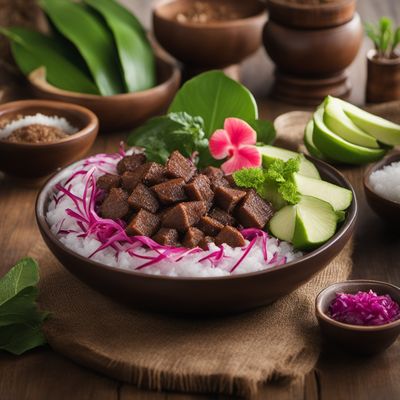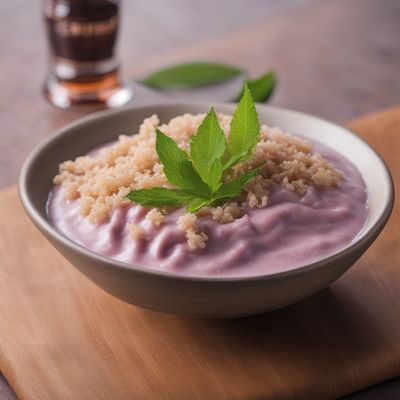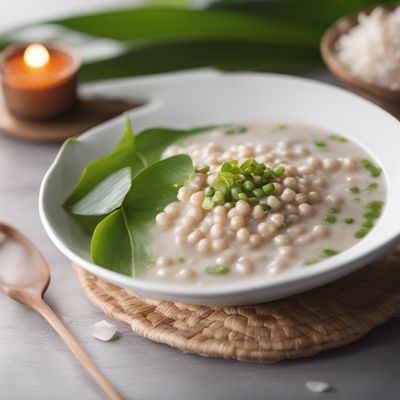
Ingredient
Taros
The Versatile Taro Root
Taro root is a starchy tuber that has a rough, brown outer skin and a creamy white flesh. It has a slightly sweet and nutty flavor, with a texture that can range from firm to soft depending on how it is cooked. Its appearance is similar to a potato, but with a distinct purple or white speckled pattern on the inside.
Origins and history
Taro root has a long history and is believed to have originated in Southeast Asia. It has been cultivated for thousands of years and is an important staple in many tropical and subtropical regions. It holds cultural significance in various cuisines, including Hawaiian, Polynesian, and Asian cuisines.
Nutritional information
Taro root is a good source of dietary fiber, vitamin E, potassium, and magnesium. It is also low in fat and calories, making it a healthy addition to a balanced diet.
Allergens
Taro root may cause allergic reactions in some individuals, particularly those who are allergic to other root vegetables such as potatoes or yams.
How to select
When selecting taro root, look for firm, unblemished roots with a smooth skin. Avoid any roots that have soft spots, mold, or signs of decay. The skin should be free of cracks or bruises. Choose smaller to medium-sized roots, as they tend to be more tender and flavorful.
Storage recommendations
To store taro root, keep it in a cool, dark place with good ventilation. Do not refrigerate, as the cold temperature can cause the root to become mushy. It can be stored for up to two weeks. Once cooked, taro root should be stored in an airtight container in the refrigerator and consumed within a few days.
How to produce
Taro root can be grown in tropical or subtropical regions with warm temperatures and high humidity. It requires well-drained soil and regular watering. Plant the root in a sunny spot and harvest it when the leaves start to turn yellow and wither.
Preparation tips
Taro root can be boiled, steamed, roasted, or fried. It is commonly used in soups, stews, curries, and stir-fries. It can also be mashed or pureed and used in desserts such as taro bubble tea or taro-flavored ice cream. Before cooking, taro root should be peeled and cut into the desired shape. It is important to note that taro root should never be consumed raw, as it contains calcium oxalate crystals that can cause irritation to the mouth and throat.
Substitutions
Sweet potatoes can be used as a substitute for taro root, as they have a similar texture and flavor. However, the taste may be slightly different. Other alternatives include yams or cassava.
Culinary uses
Taro root is commonly used in dishes such as poi (a traditional Hawaiian dish), taro chips, taro dumplings, and taro cake. It is also used in Asian desserts such as taro buns and taro mochi. In Polynesian cuisines, taro leaves are often used to wrap and cook meat or fish.
Availability
Taro root is widely available in tropical and subtropical regions, including Southeast Asia, the Pacific Islands, and parts of Africa and the Caribbean.
More ingredients from this category
Recipes using Taros » Browse all

Oceanic Seafood Soup
Tropical Delight Seafood Soup

Nauruan-style Oxtail Soup
Savory Oxtail Delight: Nauruan-style Soup

Samoan Coconut Taro Mash
Tropical Delight: Creamy Coconut Taro Mash

Traditional Hawaiian Poi
Tropical Taro Delight

Samoan Coconut Taro Pudding
Tropical Delight: Creamy Coconut Taro Pudding from Samoa

Daheen alla Toscana
Tuscan-inspired Creamy Daheen Delight

Lowcountry Taro Rösti
Savory Taro Delight: Lowcountry Taro Rösti

Coconut Delight Bubur Cha Cha
Tropical Bliss: Coconut Delight Bubur Cha Cha

Lao-style Taro Mash
Savory Taro Delight: Lao-style Taro Mash Recipe

Undhiyu - Gujarati Winter Vegetable Stew
Flavors of Gujarat: A Hearty Winter Vegetable Stew

Filipino-style Metemgee
Savory Rice and Root Vegetable Stew: A Filipino Twist on Metemgee

Crispy Puerto Rican Cala Fritters
Savory Delights: Crispy Cala Fritters with a Puerto Rican Twist

